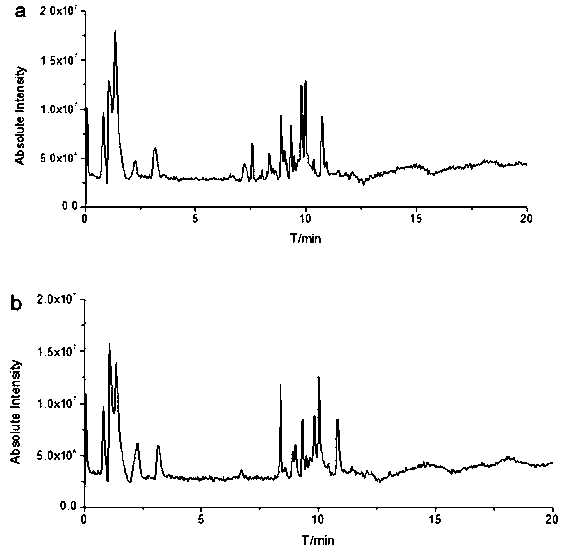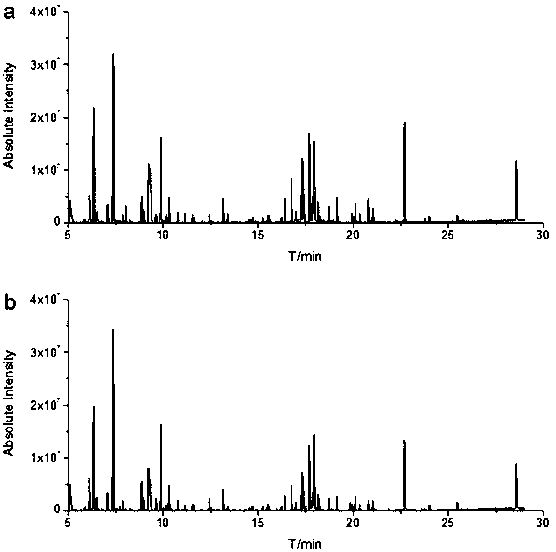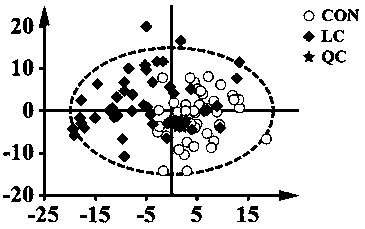Application of a group of plasma metabolic small molecule markers related to early diagnosis of lung cancer
A technology for metabolizing small molecules and early diagnosis, applied in material separation, analysis materials, instruments, etc., can solve the problems of high missed or misdiagnosed rate, low detection rate of markers, limited clinical application, etc. Improve sensitivity and specificity, and achieve the effect of accurate judgment
- Summary
- Abstract
- Description
- Claims
- Application Information
AI Technical Summary
Problems solved by technology
Method used
Image
Examples
experiment example 1
[0043] one. Objectives and methods
[0044] 1. Specimen collection and processing
[0045] Whole blood samples from 43 healthy volunteers and 43 patients with preoperative lung cancer were collected and placed in the 2In EDTA blood collection tubes, centrifuge at 4°C, 8000rpm for 10min, take the upper layer of plasma and EP tubes, and quickly put them in -80°C and refrigerate for testing. Take 20 µL each from the plasma samples of healthy volunteers, mix well to prepare QC samples, and store them in the same way.
[0046] 2. Main reagents
[0047] Heptadecanoic acid (content>99.9%), methoxyamine hydrochloride (MOX, content>99.9%), N-methyltrimethylsilyltrifluoroacetamide (MSTFA, content>99.9%) and pyridine were purchased from Sigma-Aldrich (St.Louis, MO, USA); formic acid, methanol, and acetonitrile (HPLC reagents, Merck, Germany); ultrapure water (MILIQ ultrapure water device from Milipore, USA).
[0048] 3. Detection and identification of differential metabolites in pla...
Embodiment 2
[0088] Embodiment 2: the preparation of detection kit:
[0089] Based on the small molecule markers of plasma metabolism provided by the present invention, a detection kit is prepared, which contains the following components:
[0090] Standards for small molecule markers of plasma metabolism: containing propionic acid, aspartic acid, glucofuranoside, citric acid, allose, talose, galactopyranose, pyruvate, tryptophan, leucylproline Amino acid, glycerophosphatidylcholine, oleoylcarnitine, lysophosphatidylcholine (18:3), lysophosphatidylcholine (18:2), lysophosphatidylcholine (18:1), lysophosphatidylcholine Choline (22:6), Lysophosphatidylethanolamine (20:0), Lysophosphatidylethanolamine (18:2), Tyrosylvaline;
[0091] Plasma metabolite extraction solvent: a mixed solution of methanol and acetonitrile at a ratio of 1:1, 80% aqueous methanol solution (for UPLC-IT-TOF / MS sample preparation); methanol, methoxyamine hydrochloride and N-methyl trimethyl Silicon-based trifluoroacetam...
PUM
 Login to View More
Login to View More Abstract
Description
Claims
Application Information
 Login to View More
Login to View More - R&D
- Intellectual Property
- Life Sciences
- Materials
- Tech Scout
- Unparalleled Data Quality
- Higher Quality Content
- 60% Fewer Hallucinations
Browse by: Latest US Patents, China's latest patents, Technical Efficacy Thesaurus, Application Domain, Technology Topic, Popular Technical Reports.
© 2025 PatSnap. All rights reserved.Legal|Privacy policy|Modern Slavery Act Transparency Statement|Sitemap|About US| Contact US: help@patsnap.com



